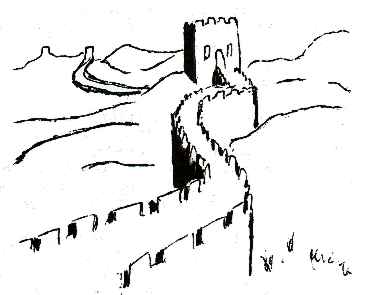CHINA HOLIDAY
SHEILA ASQUITH
Area 9.
"Kung he fah choy" - our Chinese students met me and their home tutor with big smiles and the traditional handclasp as they gave us a Happy New Year greeting, given shyly and less confidently by some of the people we met on holiday in Pekin early last year. It seems odd that in visiting a city of nine million people we made so little contact with them and that our memories are mainly of places - but what places!
The Forbidden City was impressive with it`s palaces, pavilions, temples and courtyards. The Summer Palace delightful with it`s gardens, pavilions, lakes and many different shaped bridges all photogenic and all hopelessly overcrowded. Tien-A- Men Square, the largest square in the world capable of holding a million people. The Great Wall of China looking unbelievable even when standing on it. By the time we got to the Terracotte Army at Xian we had run out of superlatives and we can only say indescribable and truly unforgetable.
But if we met few people the ones that we did meet left a lasting impression. Our first unexpected encounter with private enterprise was an ancient-looking man, well are of the photogenic value of his wrinkled face and long sparse beard, making it quite clear he did not mind being photographed once and that his fee was in paper money, not coinage, all without a word exchanged. Proud grandparents who allowed photographs of themselves with children - without a fee. Two very dignified old ladies posing well even if a bit rigid; but the liveliest of all was a Kindergarden group picnicing in the park, a delightful troupe of five-year olds. Full of happy smiles.
There were several occasions when people made it clear that they did not wish to be included in any photograph. We usually respected their wishes but there was one picture my husband, Brian, felt he had to take when he saw a woman mending shoes in the street. He could not resist sneaking a shot of her, stilling his conscience by saying he felt sure she would not have minded if he could only have explained that shoe repairing is his job too. There was an incident in Xian when I wanted to photograph a little boy in a pram. These prams are most unusual bearing resemblance to a mobile playpen than anything else. I indicated to grandma that I would like to take a picture of her and the baby if she was willing. No problem - they posed nicely by the pram, Grandma smiling from ear to ear. I had taken one shot when a passerby started to shout at her. She gave back as much as she got and I, astounded by all this from what appeared to be a complete stranger, went to find our Chinese guide. He explained the obvious, that the man was abusing the woman for allowing the photograph to be taken but he could not (or perhaps would not) sat why. Peace was restored by the appearance of a policeman. The odd thing about this is that when we came to mount our pictures later, that one was not there! Out of all the photographs I took, that must have been so dark it was thrown away unrecognised - but why? The one before and the one immediately after are all there, perfectly exposed.
There was a wide range of cameras in evidence, single lens reflex, twin-lens reflex, bellows and Polaroid type; large and small format, most of them made by Seagul Cameras. Film was widely available (mostly Konica) at the shops we visited; we did not see any Kodak or Ilford. The Black & White films were Chinese made. We met several unmistakable camera club outings when mutual inspection of camera gear took place, usually without a common language. The use of tripods was almost obligatory even for family pictures. Posing was regarded very seriously even in crowded places. We saw two street exhibitions, possibly the local camera clubs again. The standard was very high with a range of subject matter on show. The prints were displayed behind glass in structure like a long open fronted bus shelter - no graffitti or even marks on the glass.
It is difficult to meet ordinary people - that is people not connected with the tourist trade in some way or another, when you are on an organised tour and with no knowledge of the local language, impossible to talk to the few who we encountered. The closest we came to everyday life of a Chinese family was when we were taken to a Commune to meet two very charming women who showed us around their homes and answered our questions through an interpreter. Cynics will suggest that we were only shown and told what fitted into the party line. And of course that may well be so but it is true that these women were very happy to receive us and were very relaxed with us. It seemed to me that the Common system worked well for them.
I am sure you will have noticed in my opening remarks I said we made little contact with the people of China and that our memories are mainly of places and yet those unforgetable places have taken no more than one short paragraph; there are many guide or travel books which describe all these places better than I can. The Queen's visit last year brought the scenes that we had seen to our television screens so that you saw almost as much as we did. It is the people who make or break a holiday by interaction or response and the few contacts we did make made our holiday one to remember.
